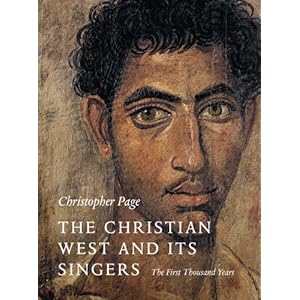 Protestants have their Bible commentaries, and Catholic Musicians have Chants of the Vatican Gradual by Dominic Johner.
Protestants have their Bible commentaries, and Catholic Musicians have Chants of the Vatican Gradual by Dominic Johner.
His writing causes you absolutely to fall in love with every Gregorian chant applicable to every Sunday of the year. Each little essay is a treasure of insight and erudition – musical, liturgical, and theological. I can’t even imagine the discipline it took to write this. It must have take half his life. To know what he knew also would require daily praying of these chants for many years. What a beautiful life, and a beautiful book.
 For a more contemporary reflection on chant, consider Gregorian Chant: A Guide.
For a more contemporary reflection on chant, consider Gregorian Chant: A Guide.
Dom Daniel Saulnier is the master of Gregorian chant at the Solesmes monastery in France, and this is his book of historical, musicological, and spiritual reflections on the science, art, and prayer of the sung prayer of the Roman Rite of Catholic liturgy. His text incorporates the latest scholarship on this ancient tradition of music. This edition was translated by Edward Schaefer, published by Solesmes in 2003 and then again in 2010 by the Church Music Association of America. So it is something of a wonder that we are able to offer this book, which had been tied up under copyright for some years.
 It is not possible to say enough great things about Christopher Page’s The Christian West and Its Singers.
It is not possible to say enough great things about Christopher Page’s The Christian West and Its Singers.
It is the best possible gift for the singer who is special in your life. The production values of the book are stunning, even old world. The contents are constantly engaging, due to the prose, the subject matter, and the level of research. It’s the kind of book that pretty well ties people up for about a century of learning and standing in awe. I simply cannot believe that it will ever be outdone.
 There is some irony in the fact that the Oregon Catholic Press is the publisher of three of the best new recordings of Gregorian chant available on the market today, and all three are geared for parish use. Every single Catholic singer could benefit from these, and so could pastors.
There is some irony in the fact that the Oregon Catholic Press is the publisher of three of the best new recordings of Gregorian chant available on the market today, and all three are geared for parish use. Every single Catholic singer could benefit from these, and so could pastors.
They are fantastic for playing in the hallways at the parish or during confession services or just for providing excellent teaching moments for everyone. The choir is one of the best in the country. The titles are “Inclina Domine,” “O Lux Beatissima,” and “Cantemus Domino.” All three are essential. I’m especially impressed that these are not art recordings but liturgical recordings, designed to evangelize and present the best possible renderings of chant.
 Everyone likes a good introduction to a topic, and the best ever written on Gregorian chant is David Hiley’s book for Cambridge.
Everyone likes a good introduction to a topic, and the best ever written on Gregorian chant is David Hiley’s book for Cambridge.
It is thorough, entertaining, balanced, and fills in the gaps you develop from reading blogs and forums all the time. It provides a nearly comprehensive overview with a special focus on liturgical use. So we aren’t talking about some impenetrable academic book on musicology here. This is a fast-paced introduction that tells regular singers what they need to know.



 The Ave Maria (or ‘Hail Mary’) remains one of the most widely repeated prayers among the world’s Christian population, especially Catholics. It has been said by the faithful both in private and in public for centuries. Many know that the prayer contains two parts. The first part derives from the Gospel of Luke; the second part (beginning ‘Sancta Maria…’ [or ‘Holy Mary…’]) is simply an attached petition, not based on Scripture. The second part of the prayer is thought to have emerged and transmitted orally in the fifteenth century in various forms, later solidified with the issue of the Roman breviary in 1568.
The Ave Maria (or ‘Hail Mary’) remains one of the most widely repeated prayers among the world’s Christian population, especially Catholics. It has been said by the faithful both in private and in public for centuries. Many know that the prayer contains two parts. The first part derives from the Gospel of Luke; the second part (beginning ‘Sancta Maria…’ [or ‘Holy Mary…’]) is simply an attached petition, not based on Scripture. The second part of the prayer is thought to have emerged and transmitted orally in the fifteenth century in various forms, later solidified with the issue of the Roman breviary in 1568. Protestants have their Bible commentaries, and Catholic Musicians have
Protestants have their Bible commentaries, and Catholic Musicians have  For a more contemporary reflection on chant, consider
For a more contemporary reflection on chant, consider  It is not possible to say enough great things about Christopher Page’s
It is not possible to say enough great things about Christopher Page’s  There is some irony in the fact that the Oregon Catholic Press is the publisher of
There is some irony in the fact that the Oregon Catholic Press is the publisher of  Everyone likes a good introduction to a topic, and the best ever written on Gregorian chant is
Everyone likes a good introduction to a topic, and the best ever written on Gregorian chant is